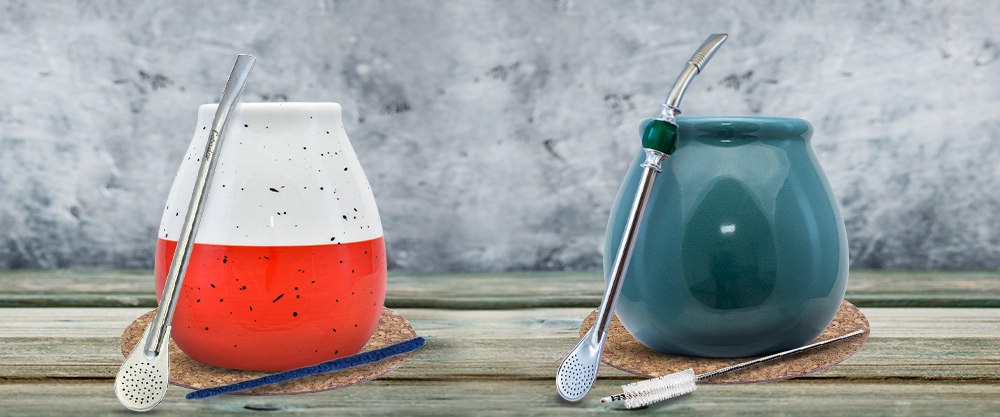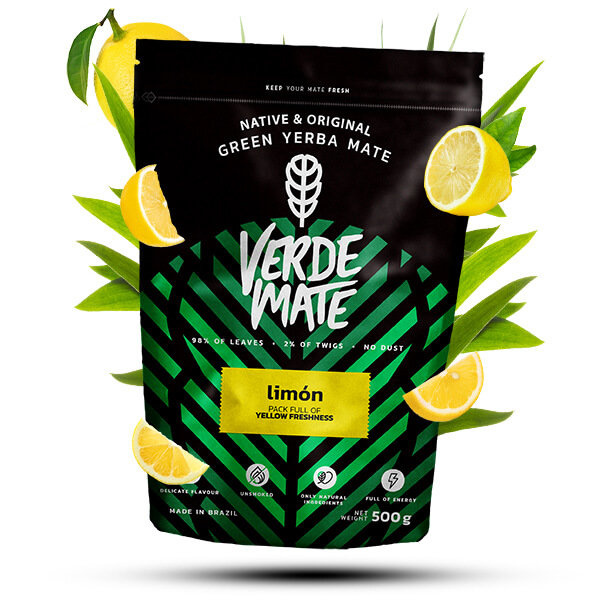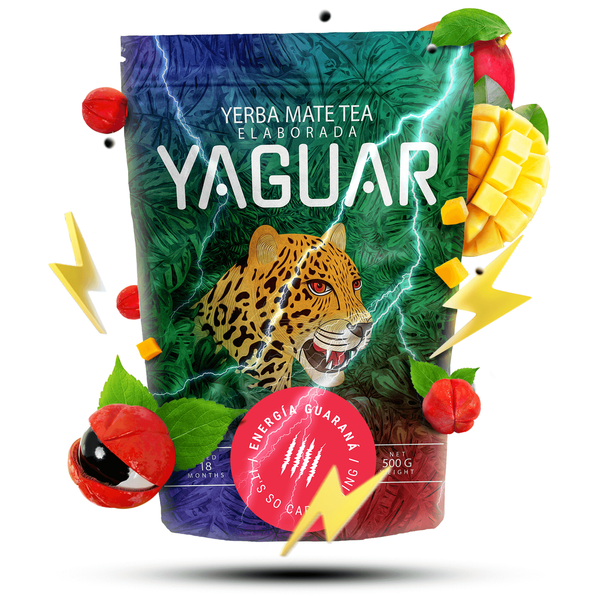Yerba mate in a nutshell. Check out our guide for beginners!

Do you want to start your yerba mate adventure but you don't know where to start or what to choose? Don't worry! We're here to answer all your questions, advise you on the best products and help you clear up your doubts! We have prepared a mini-guide to explain all the basics about yerba mate. Rest assured, we don't want to bombard you with a huge amount of information – this will be a condensed form of knowledge about the Guarani Indian brew. You can read the rest on our blog. So, shall we get started?
Summary:
- What is yerba mate?
- What are the types of yerba mate?
- What are the necessary accessories for brewing and drinking yerba mate?
- How to brew yerba mate?
- Drink yerba mate, cheers!
Looking for a yerba mate to start with? Check out our yerba mate starter kits!
What is yerba mate?
Let's start from the beginning. What is yerba mate? You may have already heard of it. Maybe your friend, sister or neighbour drinks it and you wonder what this strange, muddy drink tastes like, which is drunk in a round cup, using a strange metal straw? Why do yerba mate lovers prepare the brew with anointing and drink it as if it is nature's greatest miracle? Because it is! Yerba mate is an infusion made from the dried and crushed leaves (and twigs) of holly (Latin: Ilex paraguariensis), a plant that is found only in South America, on the borders of four countries: Brazil, Paraguay, Argentina and Uruguay. Hundreds of years ago, this area was inhabited by the Guarani Indians and they were the first to discover the plant's amazing properties. They noticed that, by chewing leaves of the plant, they had more energy, did not feel tired, their senses were sharpened, their concentration improved, and they felt much less hungry. This effect proved to be very useful during day-long hikes and hunting trips. Later, the Indians began to make an infusion from the dried leaves of the plant – a bitter, astringent and intensely herbal drink that became part of their daily life. In the 17th century, the Jesuits arrived in South America and took an interest in Indian life. The herbal brew, which the Guarani surrounded with an almost religious cult, could not have escaped their notice therefore. The Jesuits fell in love with yerba mate and made sure that it was also heard of outside South America. Today, yerba mate is an integral part of the culture of the Latin American people, who love to share mate with everyone – family, friends and even strangers. Yerba mate is a "brew of friendship" and a true lifestyle! Yerba mate has become famous primarily for its stimulating properties, which are due to the caffeine it contains. It is a completely healthy and natural alternative to coffee and artificial energy drinks. However, these are not all its benefits. It is also rich in vitamins, minerals and other organic compounds, which make it excellent for the functioning of the entire body.
You can read more about the properties of yerba mate on our blog – Yerba mate – properties. What is the green drink from South America?
Each country has its own customs, which is why the brew is prepared slightly differently in each “mate-country”, although always from the same plant – Ilex paraguariensis. What is constant is the method of preparation, the necessary accessories and the importance it has for the Latin American people. So are you wondering what types of yerba mate are there, how to drink the brew and what you need to start your adventure? Read on!
What are the types of yerba mate?
There are several types of yerba mate, depending on the country of origin and the characteristics of the dried product, related to the production method and the various additives.
Types of yerba mate according to country of origin:
- Argentine yerba mate – is the most “classic” type of yerba mate, usually dried using the traditional method of brief exposure to the flames of the fire, sometimes additionally smoked. It is usually subjected to a long ageing period, which gives it a more refined, harmonious character. The dried product contains medium-cut leaves, a fair amount of sticks and some dust. Examples of yerba mate brands: Kraus, Rosamonte;
- Brazilian yerba mate – here yerba mate is drunk in several ways:
- mate green – coarsely cut leaves of Ilex paraguariensis, virtually free of twigs and dust. This yerba mate is hot air dried and not aged, so it retains its juicy green colour and fresh, mild flavour. A great option for starting your yerba mate adventure! Example: Verde Mate Green,
- chimarrão – yerba mate ground to a very fine dust, almost resembling flour. It has a luscious green colour, and to prepare and drink it you need a special vessel (cuia) and a bombilla with a very fine filter (bomba). Example: Verde Mate Green Chimarrao,
- tereré – cold yerba mate. At the production stage, the dry product is prepared in such a way that it tastes great when drenched in both hot and ice-cold water. Example: Verde Mate Green Terere;
- Paraguayan yerba mate – is quite finely ground leaves, with a fair amount of sticks and dust. Its most distinctive flavour is intense, bitter and astringent, which it owes to being dried using fire and smoke. Paraguayan yerba mate is one of the strongest in terms of flavour and effect, which is why we recommend it to more advanced mate drinkers. Examples: Guarani, El Fuego;
- Uruguayan yerba mate is finely cut leaves with lots of dust (and sometimes a bit of twigs). Uruguayan yerba mate does not actually usually come from Uruguay – due to the unfavourable economic situation, no yerba mate is produced in the country and it is imported from Brazil. Brazilian mate intended for the Uruguayan market is usually labelled “Tipo PU1” on the packaging. Example: Armino Clasica, Canarias
Types of yerba mate according to additives:
- traditional yerba mate – 100% yerba mate, without additives or flavourings. On the packaging of such products, you will often find terms such as classica, tradicional, despalada, elaborada, con palo or sin palo. Examples: Verde Mate Green Despalada, Kurupi Clasica, Pajarito Elaborada con Palo Tradicional;
- herbal yerba mate, are aromatic fusions of yerba mate with functional herbs. The most common herbal offerings include mint, lemon verbena and dried flower petals. Less obvious herbal additions include, for example: poleo, burrito, boldo, catuava... Herbs not only accentuate the flavour of Ilex paraguariensis and add a pleasant refreshment, they often also introduce interesting properties, such as aiding digestion or being a support for weight loss. Examples: Soul Mate Siempre, CBSé Hierbas Serranas, Amanda Compuesta con Hierbas, Verde Mate Green Fitness;
- flavoued and fruit-infused yerba mate – original combinations of yerba mate, aromas (usually natural) and fruit in various forms (e.g. dried, lyophilized or candied). Flavours and fruits soften the slightly intense taste of yerba mate and offer countless possibilities for creating original flavour compositions. Fruity yerba mates are particularly recommended for the beginning of the mate-journey. Examples: Verde Mate Green Very Strawberry, CBSé Frutos del Bosque, Yaguar Mango Tango;
- organic yerba mate – originating from organically certified plantations. Ilex paraguariensis grows there without the use of chemicals or artificial plant protection products, and the production process is subject to strict quality control. Examples: Soul Mate Organica, Kraus Organica, Verde Mate Green Organica;
- extra stimulating yerba mate – these are usually enhanced by the addition of guarana, which provides an extra dose of caffeine. Examples: El Fuego Energia Guarana, Guarani Energia con Guarana, CBSé Energía Guarana.
You can read more about the types of yerba mate on our blog – Types of yerba mate – what true mate lovers drink?
Glossary of terms most commonly appearing on yerba mate packaging:
- elaborada, elaborada con palo or just con palo – yerba mate which, in addition to the leaves (and dust), contains a high proportion of sticks (approximately 35%);
- elaborada despalada, elaborada sin palo or just despalada – yerba mate without or with a small proportion of sticks (maximum 10%);
- chimarrão – yerba mate ground to a very fine dust. This type of mate is drunk in Brazil;
- seleccion especial – specially selected yerba mate, made from the highest quality leaves of Ilex paraguariensis;
- tostada – roasted yerba mate. Leaves of Ilex are roasted in a special oven, which makes them darker, brown in colour and gives them a characteristic flavour and aroma. Notes of cereal coffee and chocolate are perceptible in the infusion made from this type of dried tea. Yerba mate tostada also tastes very good when infused with milk, instead of water;
- cocido – yerba mate in tea bags or instant form.

What are the necessary accessories for brewing and drinking yerba mate?
If you've already managed to choose your first yerba mate to start with, it's time to stock up on the accessories needed to brew and drink it. What will you need?
- bombilla – is a special filtering tube whose function is to separate the brew from the grounds. It is finished with a filter that stops the leaves and twigs during drinking so that they do not enter the mouth. The most versatile are bombillas made of stainless steel. For the beginning of your yerba mate adventure, we recommend the Mercedes bombilla.
- mate gourd is a specially shaped vessel in which a brew is prepared. Mates are made of different materials and have different shapes, so there are several types of them:
- palo santo – a vessel made from the "sacred wood" of palo santo, which has "magical" properties. Yerba mate prepared in such a vessel acquires a unique taste and aroma;
- calabash – a vessel made from the natural fruit of the calabash. Like the palo santo, the calabash “gives back” its unique flavour and aroma to the yerba mate brew. You can read more about calabashes here;
- guampa – this is a specially shaped mate gourd that is used to drink the cold version of yerba mate – tereré. Originally, guampas are made of bull’s horn, but you can also find guampas made of palo santo, calabash or ceramic;
- ceramic mate gourds – this is the most popular type of yerba mate vessel. Ceramic mate gourds are relatively inexpensive, come in many designs and colours, on top of being easy to maintain – you can put them in the dishwasher and wash them with detergents without worry. Unlike a calabash or palo santo vessel, a ceramic mate gourd will not rot if you forget to throw away any leftover yerba mate. Because of their shape, which resembles a natural calabash, ceramic mates are often also called calabashes;
- other accessories – bombilla and mate gourd are the basic tools for brewing and drinking yerba mate, but this can be made easier with a few additional accessories, such as:
- bombilla cleaner – a special wire coated with a material that makes it possible to clean bombillas in hard-to-reach nooks and crannies;
- yerba mate scoop – wooden spoon which makes it easier to measure out the right amount of dried product;
- cork coaster – protects the surface of the countertop on which you place the mate gourd from the effects of heat;
- thermometer – it makes it easier to measure the temperature of the water, which is very important when brewing, as you will read later in this article;
- thermos – makes it much easier to drink yerba mate outside the home – at work, school, university or when travelling. We particularly recommend the Yerbomos, which combines the three functions of a vessel, thermos and bombilla;
- yerbera – yerba mate tin, which facilitates the storage of the dried mate. The metal tin protects the dried product from weathering, sunlight, moisture and other factors that can affect the taste and aroma of yerba mate.
How to brew yerba mate?
You've already got your first yerba mate, mate gourd and bombilla – now it's time to prepare the brew! Brewing yerba mate is a kind of ritual, so it is worth remembering a few rules. Don't worry, there is nothing difficult about it and you will soon get into the habit!
How to brew yerba mate? Four simple steps:
- Pour the dried product into the mate gourd. Start with a smaller portion, about 15g (2-3 teaspoons), then you can gradually increase the amount.
- Make a “mound” of yerba mate – shake the gourd vigorously and tilt it slightly so that the dry product sits on one wall of the vessel.
- Place the bombilla on the “mound”, with the filter downwards – so that it touches the bottom of the vessel.
- Pour water into the vessel. Aim for the place where there is the least amount of yerba mate. Very important: do not pour boiling water over the dry product. Water that is too hot will scald the leaves and make the infusion very bitter and the holly will lose its valuable properties. The optimum temperature for brewing yerba mate is around 70-80°C.
Want to become a true master of yerba mate brewing? Read our blog post: Brewing yerba mate. A beginner’s guide. And from this article you will learn how to brew yerba mate when you don't have a calabash and bombilla near at hand.
Methods of brewing yerba mate
The basics of brewing yerba mate are one thing, and once you've mastered them, you can start experimenting. As it turns out, mate tea can be drunk in a variety of ways:
- traditionally – yerba mate poured over hot water at a temperature of about 70-80°C;
- tereré – cold yerba mate. Instead of hot water, cold water is used and ice cubes are often added. The water can be replaced by frozen juice. The cold version of yerba mate is very refreshing and is especially good on hot days;
- cocido – yerba mate in tea bags or in soluble form. It can usually be poured in boiling water;
- tostada – roasted yerba mate. It can be poured over water, water with added milk or replace water completely with milk. Vegetable milk also works very well;
- experimental – what the Ilex paraguariensis has in common is that it combines very well with different flavours. Thus, pieces of fruit, dried citrus peels, fresh herbs and even sweeteners can be added to the yerba mate vessel. Water can be replaced by fruit juice, milk or even beer. The possibilities are many and it is worth experimenting on your own in search of your own taste!
Drink yerba mate, cheers!
With this dose of knowledge, you can set off on your yerba mate adventure! In order to get to know the different flavours better, we recommend the yerba mate sample sets to start with – with samples packaged in 50g. This way, you will not only get to know the different brands, but also the different types of yerba mate – from the classics, herbal and fruity to the strongest stimulating ones. This way, it will be easier to choose yerba mate in a full-size pack later on.
An optimal option for starting out is also to choose a starter kit with yerba mate and accessories, and if you want to drink yerba with someone else – we recommend yerba mate sets for couples in which all the products are double.
Are you ready for an encounter with yerba mate? Grab your mate gourd and bombilla in hand and enjoy the goodness of the Guarani Indian brew. Cheers!




